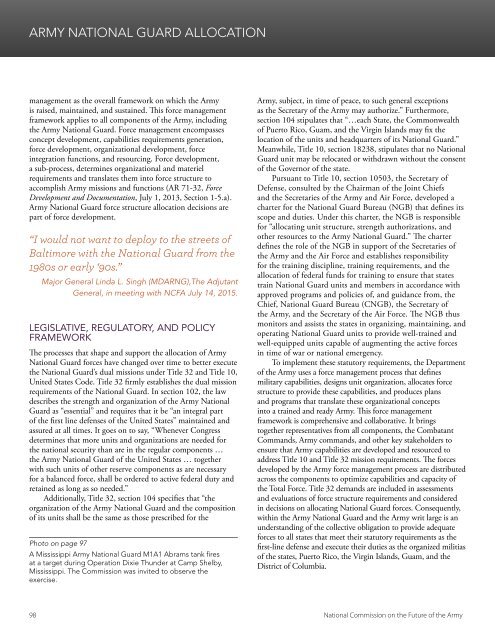THE FUTURE OF THE ARMY
Futurearmy
Futurearmy
Create successful ePaper yourself
Turn your PDF publications into a flip-book with our unique Google optimized e-Paper software.
<strong>ARMY</strong> NATIONAL GUARD ALLOCATION<br />
management as the overall framework on which the Army<br />
is raised, maintained, and sustained. This force management<br />
framework applies to all components of the Army, including<br />
the Army National Guard. Force management encompasses<br />
concept development, capabilities requirements generation,<br />
force development, organizational development, force<br />
integration functions, and resourcing. Force development,<br />
a sub-process, determines organizational and materiel<br />
requirements and translates them into force structure to<br />
accomplish Army missions and functions (AR 71-32, Force<br />
Development and Documentation, July 1, 2013, Section 1-5.a).<br />
Army National Guard force structure allocation decisions are<br />
part of force development.<br />
“I would not want to deploy to the streets of<br />
Baltimore with the National Guard from the<br />
1980s or early ‘90s.”<br />
Major General Linda L. Singh (MDARNG),The Adjutant<br />
General, in meeting with NCFA July 14, 2015.<br />
LEGISLATIVE, REGULATORY, AND POLICY<br />
FRAMEWORK<br />
The processes that shape and support the allocation of Army<br />
National Guard forces have changed over time to better execute<br />
the National Guard’s dual missions under Title 32 and Title 10,<br />
United States Code. Title 32 firmly establishes the dual mission<br />
requirements of the National Guard. In section 102, the law<br />
describes the strength and organization of the Army National<br />
Guard as “essential” and requires that it be “an integral part<br />
of the first line defenses of the United States” maintained and<br />
assured at all times. It goes on to say, “Whenever Congress<br />
determines that more units and organizations are needed for<br />
the national security than are in the regular components …<br />
the Army National Guard of the United States … together<br />
with such units of other reserve components as are necessary<br />
for a balanced force, shall be ordered to active federal duty and<br />
retained as long as so needed.”<br />
Additionally, Title 32, section 104 specifies that “the<br />
organization of the Army National Guard and the composition<br />
of its units shall be the same as those prescribed for the<br />
Photo on page 97<br />
A Mississippi Army National Guard M1A1 Abrams tank fires<br />
at a target during Operation Dixie Thunder at Camp Shelby,<br />
Mississippi. The Commission was invited to observe the<br />
exercise.<br />
Army, subject, in time of peace, to such general exceptions<br />
as the Secretary of the Army may authorize.” Furthermore,<br />
section 104 stipulates that “…each State, the Commonwealth<br />
of Puerto Rico, Guam, and the Virgin Islands may fix the<br />
location of the units and headquarters of its National Guard.”<br />
Meanwhile, Title 10, section 18238, stipulates that no National<br />
Guard unit may be relocated or withdrawn without the consent<br />
of the Governor of the state.<br />
Pursuant to Title 10, section 10503, the Secretary of<br />
Defense, consulted by the Chairman of the Joint Chiefs<br />
and the Secretaries of the Army and Air Force, developed a<br />
charter for the National Guard Bureau (NGB) that defines its<br />
scope and duties. Under this charter, the NGB is responsible<br />
for “allocating unit structure, strength authorizations, and<br />
other resources to the Army National Guard.” The charter<br />
defines the role of the NGB in support of the Secretaries of<br />
the Army and the Air Force and establishes responsibility<br />
for the training discipline, training requirements, and the<br />
allocation of federal funds for training to ensure that states<br />
train National Guard units and members in accordance with<br />
approved programs and policies of, and guidance from, the<br />
Chief, National Guard Bureau (CNGB), the Secretary of<br />
the Army, and the Secretary of the Air Force. The NGB thus<br />
monitors and assists the states in organizing, maintaining, and<br />
operating National Guard units to provide well-trained and<br />
well-equipped units capable of augmenting the active forces<br />
in time of war or national emergency.<br />
To implement these statutory requirements, the Department<br />
of the Army uses a force management process that defines<br />
military capabilities, designs unit organization, allocates force<br />
structure to provide these capabilities, and produces plans<br />
and programs that translate these organizational concepts<br />
into a trained and ready Army. This force management<br />
framework is comprehensive and collaborative. It brings<br />
together representatives from all components, the Combatant<br />
Commands, Army commands, and other key stakeholders to<br />
ensure that Army capabilities are developed and resourced to<br />
address Title 10 and Title 32 mission requirements. The forces<br />
developed by the Army force management process are distributed<br />
across the components to optimize capabilities and capacity of<br />
the Total Force. Title 32 demands are included in assessments<br />
and evaluations of force structure requirements and considered<br />
in decisions on allocating National Guard forces. Consequently,<br />
within the Army National Guard and the Army writ large is an<br />
understanding of the collective obligation to provide adequate<br />
forces to all states that meet their statutory requirements as the<br />
first-line defense and execute their duties as the organized militias<br />
of the states, Puerto Rico, the Virgin Islands, Guam, and the<br />
District of Columbia.<br />
98 National Commission on the Future of the Army


